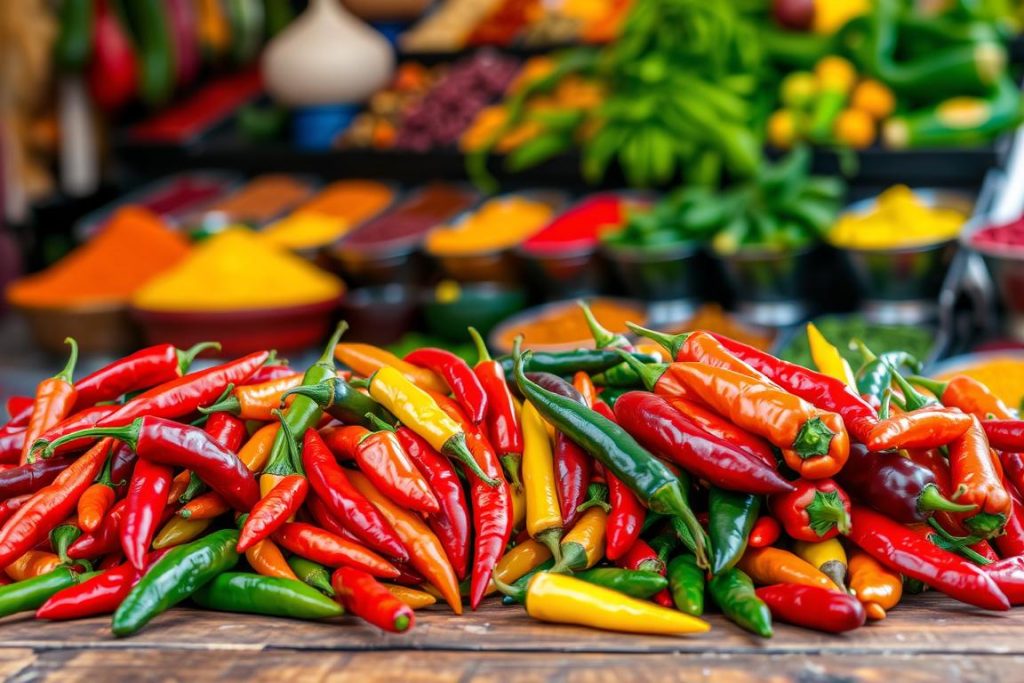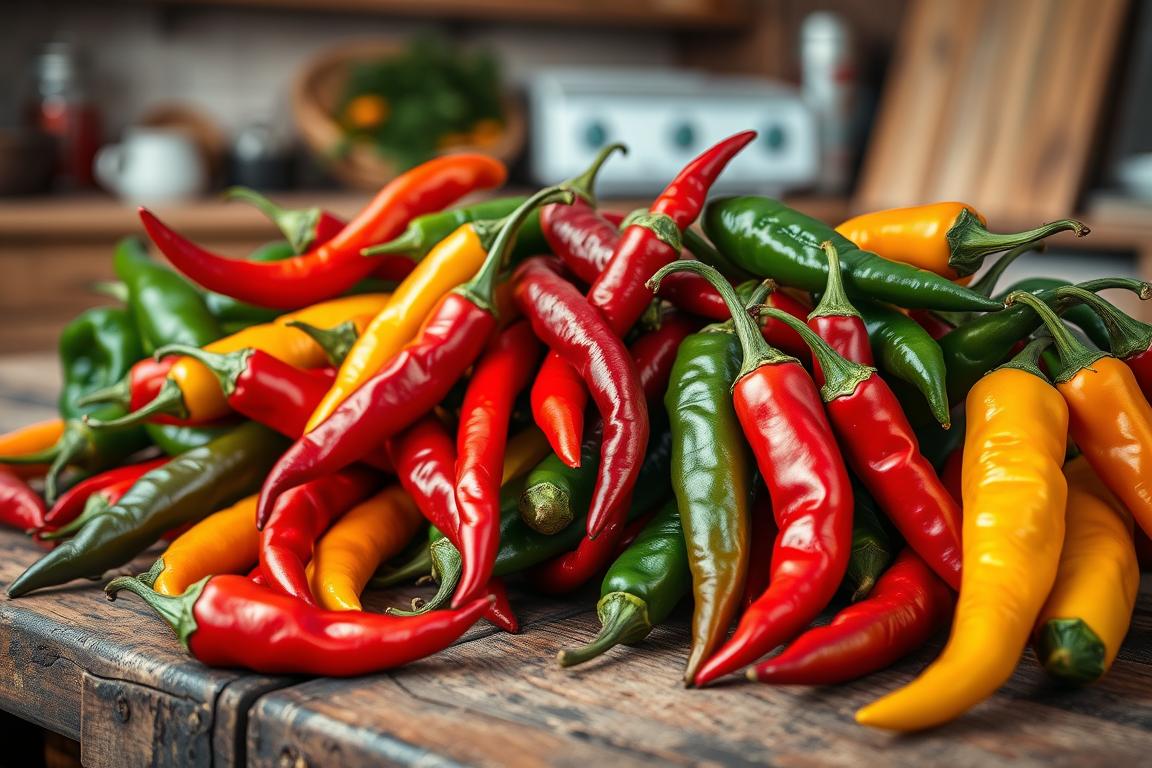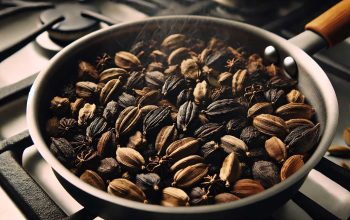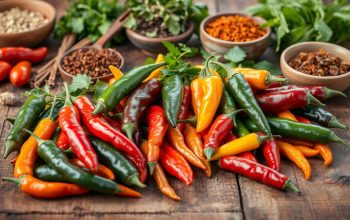Chili peppers are like a master key in the kitchen. They open up a world of flavors and heat. Whether you like a little warmth or a big kick, they can make any dish exciting. In this guide, we’ll look at chili heat levels, the best peppers for cooking, and how to use them in your cooking.
Chili peppers range from mild and sweet to intense and smoky. Knowing the Scoville scale and the unique traits of each pepper helps you cook with confidence. You’ll learn to make dishes that please everyone’s taste buds.
Understanding the Basics of Chili Heat Levels
Chili peppers’ heat is key for cooks and spice fans. The secret to their fiery power is the Scoville scale. It measures how spicy peppers are.
The Scoville Scale Explained
The Scoville scale was created by Wilbur Scoville, an American pharmacist. It shows how much capsaicin is in peppers. Capsaicin is what makes peppers hot. The scale goes from 0 SHU for bell peppers to over 2 million SHU for the Carolina Reaper.
Common Heat Level Categories
- Mild: 0-2,500 SHU (e.g., bell peppers, banana peppers)
- Medium: 2,500-30,000 SHU (e.g., jalapeños, anaheim peppers)
- Hot: 30,000-100,000 SHU (e.g., serrano peppers, Thai chilis)
- Very Hot: 100,000-350,000 SHU (e.g., habanero peppers, ghost peppers)
- Extremely Hot: 350,000+ SHU (e.g., scorpion peppers, Carolina Reaper)
Physical Effects of Capsaicin
Capsaicin makes your body feel pain, causing a burning feeling. This can make you sweat, feel flushed, and even raise your heart rate. Your body is trying to cool down and ease the discomfort.
Knowing the Scoville scale and heat levels is important for chili lovers. It helps them pick the right peppers for their dishes.
By learning about chili heat, cooks can try new peppers. They can make dishes that are just right for their taste and their guests’.
Essential Types of Chili Peppers for Cooking
Choosing the right chili peppers is key to adding flavor and heat to your dishes. From the mild jalapeño to the fiery habanero, each type has its own special qualities. Let’s look at some must-have chili peppers for every home cook.
The jalapeño is a favorite in Mexican and Tex-Mex cooking. It has a medium heat and a sweet, grassy taste. These peppers are great for salsas, marinades, and pickling. They’re perfect for those who want a bit of spice without too much heat.
The habanero is for those who love a strong kick. Hailing from the Yucatán, these peppers have a fruity, citrusy smell and a long-lasting heat. They’re used in Caribbean and Mexican dishes to add a fiery kick to sauces and rubs.
The Thai chili, or bird’s eye chili, is another must-try. These small peppers are very hot, even hotter than jalapeños. They’re a key ingredient in Southeast Asian cooking, adding a spicy kick to curries and sauces.
| Chili Pepper | Heat Level (Scoville Units) | Flavor Profile | Culinary Uses |
|---|---|---|---|
| Jalapeño | 2,500 – 8,000 SHU | Mild, grassy-sweet | Salsas, marinades, pickling |
| Habanero | 100,000 – 350,000 SHU | Fruity, citrusy, fiery | Sauces, rubs, condiments |
| Thai Chili | 50,000 – 100,000 SHU | Intense, vibrant | Curries, stir-fries, dipping sauces |
These are just a few of the many chili peppers out there. Each one offers a unique taste and heat level. By exploring these, you can create dishes that excite your taste buds. Understanding these peppers can open up a world of flavors and spice in your cooking.
Preparing and Handling Hot Peppers Safely
Working with chili peppers and other hot ingredients requires safety first. From wearing protective gear to storing them right, the right steps can make a big difference in your kitchen.
Protective Equipment and Precautions
Always wear gloves when handling hot peppers. The capsaicin in them can burn your skin. Make sure your work area has good air flow to avoid eye and breathing problems from the fumes.
Proper Storage Methods
- Keep chili peppers in the fridge in a sealed container or bag to keep them fresh and potent.
- Don’t leave hot peppers out for too long, as they lose flavor and heat quickly.
- Freezing chili peppers is a good way to store them for a long time, keeping their unique taste and heat.
First Aid for Chili Burns
If you accidentally get chili in your eyes or on your skin, act fast. Rinse the area with cool water for a few minutes. Don’t rub the skin, as it can make the burn worse. If the pain doesn’t go away, get medical help.
By following these safety tips, you can safely work with hot peppers and enjoy their flavor without worry. Remember, safety first makes cooking fun and safe.
Building Flavor Profiles with Different Peppers
The secret to amazing chili dishes is knowing how different chili peppers add flavor. By picking and mixing various peppers, anyone can make dishes that wow. This creates complex and balanced flavor profiles that excite our taste buds.
Each chili pepper has its own special taste. Ancho peppers bring sweet and fruity notes. Chipotle peppers add earthy and smoky flavors. These unique tastes can be mixed to add depth and balance to any dish.
| Pepper Type | Flavor Profile | Recommended Uses |
|---|---|---|
| Jalapeño | Bright, slightly grassy, with a moderate heat | Salsas, tacos, chili con carne |
| Serrano | Intense, vibrant heat with a fruity, herbaceous undertone | Stir-fries, marinades, hot sauces |
| Habanero | Fiery heat with a citrusy, floral aroma | Sauces, chutneys, tropical-inspired dishes |
| Ancho | Mild, sweet, and earthy with a hint of raisin | Mole sauces, braised meats, roasted vegetables |
By carefully choosing chili peppers and other ingredients, we can make dishes that look great and taste amazing. The world of flavors is vast, and the only limit is our creativity and the desire to try new things.
“The secret to great chili is in the blending of the flavors. It’s not just about the heat, but the perfect harmony of spices, ingredients, and peppers.”
Techniques for Controlling Heat in Your Dishes
When cooking with chili, it’s key to manage the heat. There are ways to adjust the heat and flavors to your taste. Let’s look at some cooking techniques to control the spice in your dishes.
Removing Seeds and Membranes
One simple way to lower the heat is to remove seeds and membranes from chili peppers. These parts have the most capsaicin, which makes things hot. By taking them out, you can make your dish less spicy but still flavorful.
Balancing Heat with Other Ingredients
Using dairy like sour cream or cheese can cool down your dish. These ingredients can ease the burning sensation from the chili peppers. You can also add herbs, citrus, or sweet things to balance the spicy flavors.
Timing Your Spice Additions
When you add chili peppers to your dish matters. Adding them early lets the flavors mix and the heat lessen. Adding them later makes it spicier. Try different times to find the right heat for you.

With these cooking techniques, you can control the heat and flavors in your chili dishes. This way, you can make sure your guests have a great time eating.
Regional Cooking Styles Using Chili
Chili peppers are a key part of many cuisines worldwide. Each place adds its own twist to using this ingredient. From India’s spicy curries to Mexico’s tangy salsas, chili shows the diversity of global cooking.
In Mexico, chili is the base for famous dishes like chili con carne and mole sauces. The choice of chili peppers, from ancho to chipotle, gives each dish its special taste. It’s all about finding the right mix of heat and flavors.
In the Caribbean, chili peppers add flavor to the food. Jamaican jerk seasoning, with its mix of chili peppers and spices, makes grilled meats and seafood taste amazing. In Trinidad and Tobago, the famous curry combines chili peppers with cumin and turmeric for a rich taste.
Asian cuisines also love chili peppers. Thai tom yum soup, with its mix of lemongrass, chili, and herbs, shows how chili can balance flavors. In India, chili peppers add heat and depth to curries and masalas.
Across all regions, chili peppers add bold, rich flavors to many dishes. Knowing about different chili types and how to use them opens up a world of cooking possibilities.
“Chili peppers are the backbone of many global cuisines, each region putting its unique spin on this versatile ingredient.”
Perfect Pairings: Complementary Ingredients
When cooking with chili, the right ingredients make a big difference. Dairy products can cool down the heat. Herbs and spices can also boost the flavors of chili. This opens up a world of recipes to explore.
Dairy Products as Heat Reducers
Dairy products can tame the heat of chili. Sour cream, yogurt, and cheese have fats and proteins that neutralize the heat. Adding sour cream to spicy chili or using cheddar cheese on tacos can balance the flavors.
Herbs and Spices That Enhance Chili Flavors
- Cumin: This spice adds depth and complexity to chili.
- Oregano: Its peppery, minty notes complement chili flavors.
- Cilantro: It brightens and balances the heat of chili recipes.
- Garlic: Freshly minced or roasted garlic enhances the savory flavors of chili.
Try mixing different dairy products, herbs, and spices. You can make chili recipes that are both delicious and well-balanced.
| Ingredient | Effect on Chili Flavors |
|---|---|
| Sour Cream | Cools and tempers heat |
| Cheddar Cheese | Adds creamy, savory notes |
| Cumin | Enhances earthy, slightly nutty flavors |
| Oregano | Provides a peppery, slightly minty complement |
| Cilantro | Brightens and balances the heat |
| Garlic | Amplifies the savory, umami flavors |
“Pairing the right ingredients with chili is like a symphony of flavors – each note contributes to the overall harmony.”
Common Mistakes to Avoid When Cooking with Peppers
Adding chili peppers to your dishes can be tricky. You might end up over-spicing or handling them wrong. These mistakes can ruin a tasty meal. Let’s look at some common errors and how to steer clear of them for great pepper recipes.
Underestimating Pepper Heat
Many people underestimate the heat of chili peppers. It’s key to know the Scoville rating before adding them. Too much of a spicy pepper can overpower other flavors.
Improper Handling of Hot Peppers
The oils in hot peppers can burn your skin and eyes. Not wearing gloves when cutting peppers is a big mistake. Always use protective gear and wash your hands well after handling.
Neglecting Flavor Balance
It’s not just about controlling heat; balance is crucial. Too much heat can mask other flavors. Try adding dairy or herbs to balance out the dish.
| Common Mistakes | Solutions |
|---|---|
| Underestimating Pepper Heat | Understand the Scoville scale and adjust pepper quantities accordingly |
| Improper Handling of Hot Peppers | Use protective equipment and wash hands thoroughly after handling |
| Neglecting Flavor Balance | Experiment with complementary ingredients to create a balanced dish |
By avoiding these common mistakes, you can cook with chili peppers confidently. With practice and attention to detail, you’ll master cooking with peppers. Enjoy the rich flavors they bring to your dishes.
Health Benefits and Nutritional Value of Chili Peppers
Chili peppers are loved in many cuisines for their taste and health perks. They have capsaicin, which is good for you. This compound adds flavor and health benefits.
Metabolism Boosting Properties
Chili peppers can speed up your metabolism. Capsaicin, the heat in peppers, boosts thermogenesis. This helps burn more calories, aiding in weight control.
Vitamin and Mineral Content
Chili peppers are packed with vitamins and minerals. They have lots of vitamin C, which is great for your immune system and skin. They also have vitamins A, K, and B6, and minerals like potassium, manganese, and iron. These nutrients are good for your health and help you meet daily needs.
| Nutrient | Amount per 1 medium chili pepper (approx. 22g) |
|---|---|
| Vitamin C | 65% of the Daily Value |
| Vitamin A | 18% of the Daily Value |
| Vitamin K | 4% of the Daily Value |
| Vitamin B6 | 6% of the Daily Value |
| Potassium | 4% of the Daily Value |
| Manganese | 3% of the Daily Value |
| Iron | 2% of the Daily Value |
Eating chili peppers can boost your health. They come in mild and spicy varieties. These peppers are full of health benefits and nutritional value.
Creative Ways to Incorporate Chili Heat
Home cooks and food lovers are finding new ways to use chili peppers. They’re adding zesty flavors to desserts and drinks. This lets them try out exciting flavor mixes.
Chili-infused chocolates and ice creams are a fun twist on sweets. Chili-spiked drinks give a unique taste experience. Adding chili to condiments like hot sauces and marinades makes them more interesting.
When using chili, it’s important to find the right balance. This means mixing the spicy kick with other ingredients well. By trying new flavor mixes, home cooks can make their dishes stand out. They can add the lively taste of chili peppers to their recipes.



